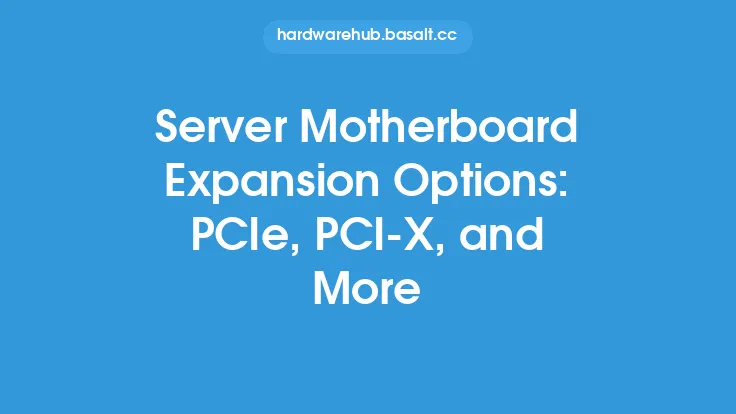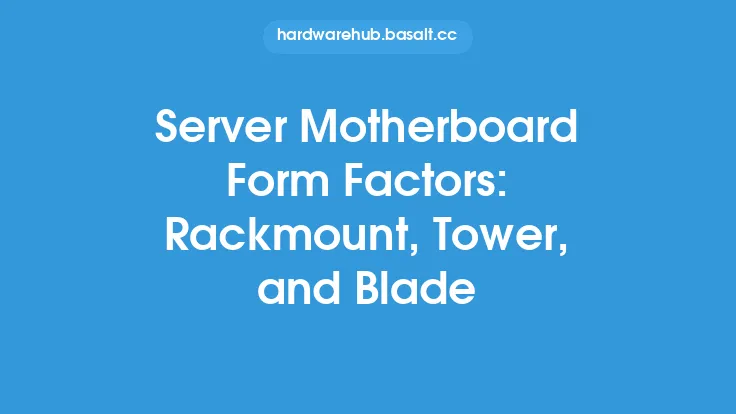Server motherboards are the backbone of any server system, providing the necessary infrastructure for various components to communicate and function together seamlessly. One of the critical aspects of server motherboards is networking, which enables servers to connect with other devices, transfer data, and provide services over a network. In this article, we will delve into the world of server motherboard networking, focusing on Ethernet, Fibre Channel, and InfiniBand technologies.
Introduction to Server Motherboard Networking
Server motherboard networking refers to the various interfaces and protocols that enable servers to connect with other devices and transfer data over a network. These interfaces can be wired or wireless and support various networking protocols, such as TCP/IP, HTTP, and FTP. Server motherboards typically feature multiple networking interfaces, including Ethernet, Fibre Channel, and InfiniBand, each designed for specific applications and use cases.
Ethernet Networking
Ethernet is the most widely used networking technology in server motherboards, providing a reliable and high-speed connection for data transfer. Ethernet interfaces on server motherboards can support various speeds, including 10/100/1000 Mbps (Gigabit Ethernet) and 10/25/40/50/100 Gbps (10GbE, 25GbE, 40GbE, 50GbE, and 100GbE). Server motherboards often feature multiple Ethernet ports, allowing for redundant connections, increased bandwidth, and improved network availability. Ethernet networking is commonly used for general-purpose networking, such as connecting servers to switches, routers, and other network devices.
Fibre Channel Networking
Fibre Channel is a high-speed networking technology designed for storage area networks (SANs) and other applications that require low latency and high throughput. Fibre Channel interfaces on server motherboards support speeds of up to 32 Gbps and are typically used for connecting servers to storage devices, such as hard disk drives, solid-state drives, and tape libraries. Fibre Channel networking is commonly used in data centers, cloud computing environments, and other applications where high-speed storage connectivity is essential.
InfiniBand Networking
InfiniBand is a high-speed, low-latency networking technology designed for high-performance computing (HPC) applications, such as scientific simulations, data analytics, and machine learning. InfiniBand interfaces on server motherboards support speeds of up to 100 Gbps and are typically used for connecting servers to other servers, storage devices, and network devices. InfiniBand networking is commonly used in HPC environments, such as research institutions, universities, and government laboratories, where low latency and high throughput are critical.
Networking Interface Controllers
Server motherboards feature various networking interface controllers, including Ethernet controllers, Fibre Channel controllers, and InfiniBand controllers. These controllers manage the networking interfaces, handle data transfer, and provide features such as quality of service (QoS), traffic management, and network virtualization. Networking interface controllers can be integrated into the server motherboard's chipset or provided as separate components, such as peripheral component interconnect express (PCIe) cards.
Networking Protocol Support
Server motherboards support various networking protocols, including TCP/IP, HTTP, FTP, and others. These protocols enable servers to communicate with other devices, transfer data, and provide services over a network. Server motherboards may also support advanced networking protocols, such as remote direct memory access (RDMA) over Ethernet or InfiniBand, which enable low-latency and high-throughput data transfer.
Network Virtualization
Server motherboards often support network virtualization, which enables multiple virtual networks to run on a single physical network. Network virtualization provides features such as virtual local area networks (VLANs), virtual private networks (VPNs), and network functions virtualization (NFV). These features enable administrators to create multiple virtual networks, each with its own set of security, QoS, and traffic management policies.
Conclusion
Server motherboard networking is a critical aspect of server design, providing the necessary infrastructure for various components to communicate and function together seamlessly. Ethernet, Fibre Channel, and InfiniBand are the primary networking technologies used in server motherboards, each designed for specific applications and use cases. By understanding the various networking interfaces, protocols, and features available on server motherboards, administrators can design and deploy efficient, scalable, and secure networks that meet the needs of their organizations. Whether it's a small business or a large enterprise, server motherboard networking plays a vital role in enabling communication, collaboration, and innovation.





